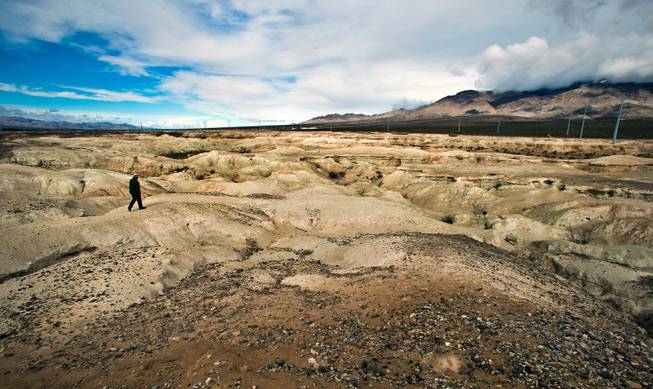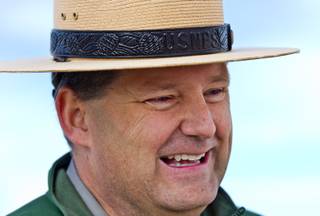
National Park Service Superintendent Jon Burpee, pictured here Wednesday, Nov. 4, 2015, is the sole employee of Tule Springs Fossil Beds National Monument and spends as much time as possible walking the large tract of land.
Monday, Nov. 16, 2015 | 2 a.m.
Hundreds of thousands of years ago, when Las Vegas wasn’t a desert, water carved a miles-long gash in the earth.
To the north lie mountains. To the south, civilization — Sun City Aliante, Aliante Casino, Starbucks.
Deep in the gash works Jon Burpee, superintendent of Tule Springs, a 22,650-acre strip of land that extends west toward Creech Air Force Base and east past Aliante.
On most days, Burpee is the only living soul for miles, apart from the occasional jackrabbit or hiker.
“The joke I keep using is that I’m the Lone Ranger,” Burpee said.
Tens of thousands of years ago, Tule Springs teemed with life. Columbian mammoths loomed. Dire wolves stalked prey. Horses, camels and bison roamed free.
They’re long dead, of course. Burpee’s job is to preserve the fossils they have left behind — and that’s not easy.
Burpee doesn’t have a budget yet. He doesn’t have staff. He doesn’t even know where the park begins and ends. The legislation that carved Tule Springs Fossil Beds National Monument from an existing piece of federal land last year only generally specified its boundaries.
Burpee has been on the job for only a month and a half, but his ties to Tule Springs run deep. He first wandered the site in the late ’90s after one of his colleagues in Death Valley told him about it. When he worked as a legislative fellow in Washington, D.C., he helped shape the legislation that created Tule Springs.
Burpee is self-effacing, quick to listen and eager to help. He says he spent his first 30 days on the job in 90 meetings with community members, park supporters, city officials, land management agencies, chambers of commerce officials, rotary clubs and homeowners associations.
“As much as I joke about the ‘Lone Ranger’ moniker, I’ve never felt lonely because there are so many people who love this place and put so much of their heart and soul into it,” Burpee said. “It’s a lot like being a part of the bigger family.”
The work at Tule Springs is just beginning. The park’s advisory council, made up of local officials and community members, will create a foundation document this fiscal year. If Burpee gets his $180,000 budget from Congress, he’ll put up more fences, start education efforts in local schools and hang signs. He also requested money through the Southern Nevada Public Land Management Act to hire a temporary volunteer coordinator and an educator for 18 months.
The Protectors of Tule Springs, a local nonprofit group dedicated to protecting the park, recently donated $20,000 to build a pair of informational kiosks to explain the park to visitors. Those will go up in the next couple of months.
As for everything else — when construction will start on a visitor’s center, where the visitor’s center will be and when the park will open — Burpee answers with one of his favorite phrases: “The planning will take us there,” meaning the park will develop on its own terms, at its own time.
It’s slow going, but that’s fast enough for Burpee and the community.
“Jon jokes that it only took 200,000 years to create Tule Springs,” said Jill DeStefano, president of Protectors of Tule Springs. “(But) it’s OK, because we have the opportunity here to create a new national park. Let’s not rush it.”
For now, Burpee spends his days meeting with community members, filling out paperwork or roaming the park. One of his top priorities is discouraging what he calls traditional “desert uses” of the land. Tule Springs long has been a shooting range, an off-roading playpen and a dumping ground. Burpee said one man sheepishly admitted he “may have gotten rid of a dishwasher out there.”
“But then — and I love this, because just as the environment is constantly changing, so are we — he said, ‘I went out there and got it. When I learned how special the place was, I went out and took care of it,’ ” Burpee said.
Dumping, graffiti and taking fossils are illegal, but Burpee wants to focus on teaching the public why protecting Tule Springs is important. Protectors of Tule Springs plan to gather volunteers for park clean-ups next year, and their more than 300 members hopefully soon will be able to volunteer for the park’s site stewardship program to monitor and report back to Burpee the status of specific plots of land.
Burpee looks forward to a time when the park has staff and volunteers on site. But for now, he’s just appreciative to have the support of the community.
“This is one of the greatest things about national parks,” Burpee said. “It’s democracy at its best. It takes passionate people to recognize the opportunity to do something special.”


Join the Discussion:
Check this out for a full explanation of our conversion to the LiveFyre commenting system and instructions on how to sign up for an account.
Full comments policy